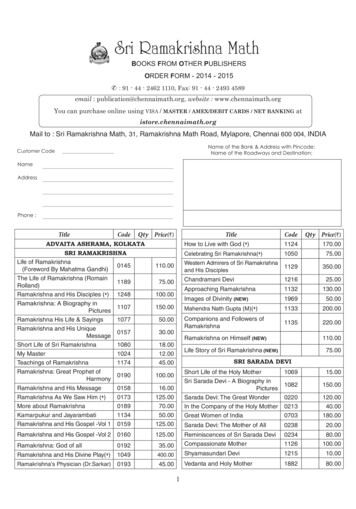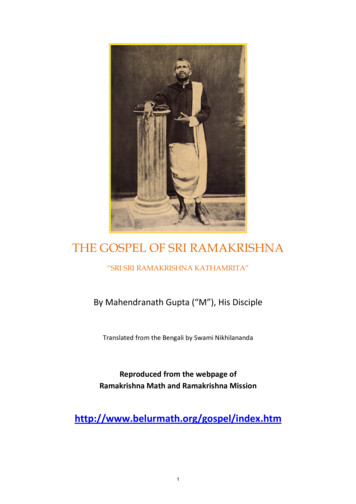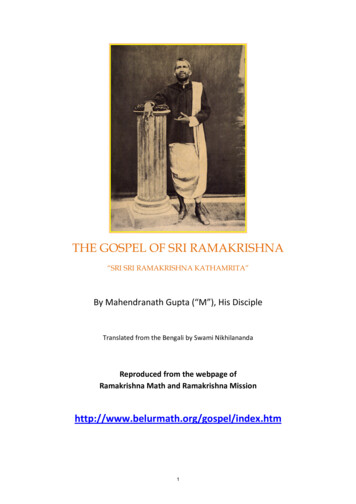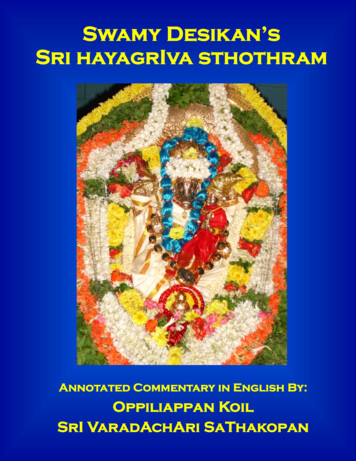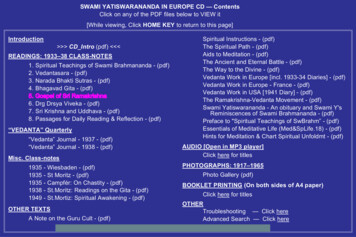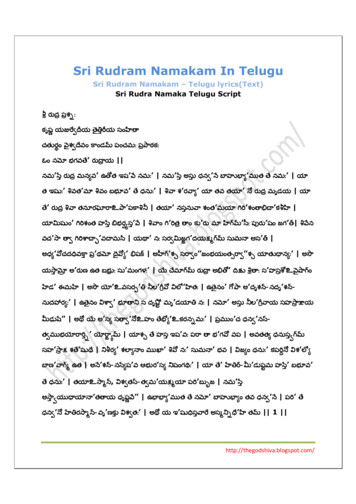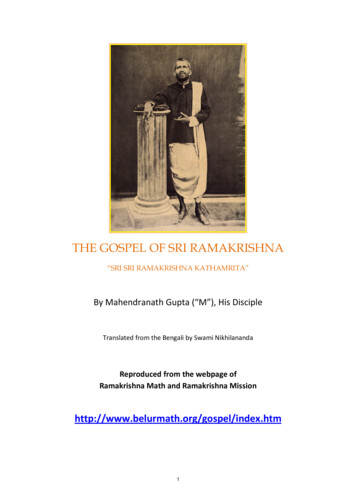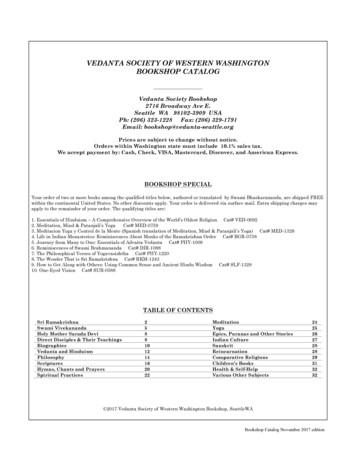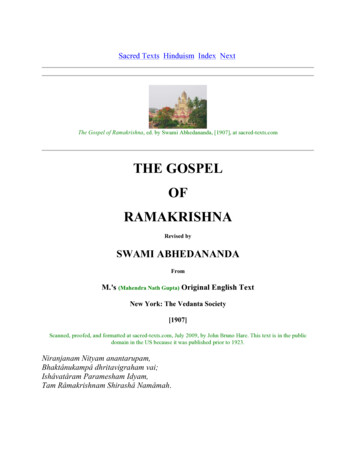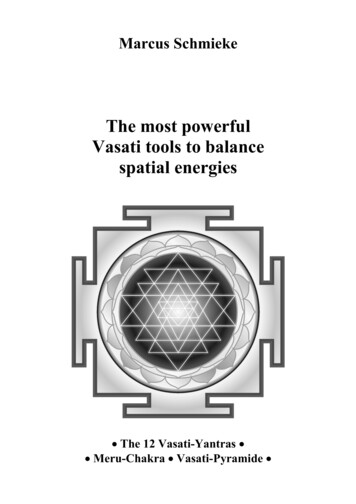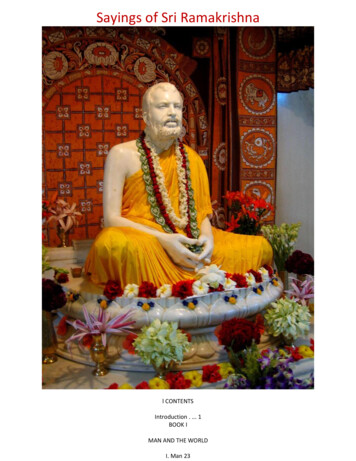
Transcription
Sayings of Sri Ramakrishnal CONTENTSIntroduction . . 1BOOK IMAN AND THE WORLDI. Man 23
II. Maya 33III. Maya as 'Woman and Gold' 37I IV. Maya as Ahamkara or Egotism 45V. Bondage of Book-learning 54I VI. Religious Teachers-False and True 61VB. The Worldly-minded and Their Ways 67BOOK IITHE ASCENT OF MANVIII. Varieties of Aspirants and Their Ideals 79IX. Some Aids to Spiritual Life 97X. Ways of Spiritual Life . . 109XI. Spiritual Aspirants and Religious Differences . 130XII. Essentials of Spiritual Life 137XIII. Yearning for God . . . . . . . . . . . 165BOOK IIIMAN AND THE DIVINEXIV. The Lord and His Devotees 172XV. Helpers in the Spiritual Path 184XVI. Jnana, Bhakti and Karma 196, IIXVII. The Divine . 230XVIII. Realisation of the Divine 244XIX. The Man of Divine Realization 256XX. Glimpses of the Master's Experiences inHis Own Words . . . . . . . 266BOOK IVMAXIMS AND PARABLESXXI. Some Maxims . . . . . . . " 287XXII. Parables 291
Index . 340CHAPTER I MANThe destiny of man― 0001-0015Real nature of man― 0016-0027Man in bondage― 0028Death and reincarnation― 0043-0047CHAPTER IIlMAYA AS 'WOMAN AND GOLD'1The bondage of sex―66-74Sex and spiritual progress―75-82How to conquer sex? ―83-89Riches and the spiritual aspirant ―90-98CHAPTER VBONDAGE OF BOOK LEARNINGBarrenness if mere book learning― 137-150Vanity if disputation― 151-158The true end if learning― 159-167CHAPTER VIITHE WORLDLY-MINDED AND THEIR WAYSCharacteristics of the worldly-minded―188-209Fickle devotion of the worldly-minded― 210-215The worldly-minded and spiritual practices―216-226BOOK IIAscent of ManCHAPTER VIIIVARIETIES OF ASPIRANTS AND THEIR IDEALSSome types of aspirants―227-239Characteristics of true aspirants―240-253Kinship of the spiritually-inclined―254-257Ideals of the aspirant entangled in theworld―258-293Ideals of the Sannyasin ―294-307CHAPTER XWAYS OF SPIRITUAL LIFESome obstacles to spiritual life―361-367Influence of past impressions―368-371Pitfalls of occult powers―372-385Dress and food ― 386-394Attitude towards the body―395-397Attitude towards ― 406-407Humility and self-respect―408-418Simplicity― 419-421Conquest of desires―422-434Attitude towards women―435-441Devotee and his family― 442-445Prayer and devotion ―446-456CHAPTER XIIESSENTIAL OF SPIRITUAL LIFECHAPTER II MAYAMaya as the Cosmic Power of the Lord― 48-53Maya as the deluding power (Avidya)―54-61Maya as the liberating power (Vidya)―62-65Some conditions of ignation to God―515-524Be mad for God―615-618Nature of true yearning― 619-626Sole condition of God-realisation― 627-638CHAPTER IVEvils of egotism― 99-109The difficulty of conquering egotism―110-114Ripe' ego and 'unripe' ego―115-118How to conquer the ego―119-128Ego in the man of realization ―129-136CHAPTER VIRELIGIOUS TEACHERS FALSE AND TRUEPitfalls of teachership― 168-175Who is a True teacher― 176-187CHAPTER IXSOME AIDS TO SPIRITUAL LIFECaste and external observances―308-321Worship of images―322-332Value of pilgrimages ― 333-337Benefits of Pious company―338-348Repetition of Divine names ―349-360CHAPTER XISPIRITUAL ASPIRANTS AND RELIGIOUSDIFFERENCESGod of all religions the same―457-461Different religions as paths to God―462-469Cause of fanaticism and its cure―470-474Right attitude to religious differences―475-487Attitude to secret cults ―?CHAPTER XIIIYEARNING FOR GOD
Necessity of Ishta or Chosen Deity—525-534Truth Brahmacharya or continence― 535-540Viveka or discrimination― 541-545Vairagya or aversion to worldly objects―546-567Perseverance―568-579Spiritual practice―580-592Concentration and meditation ― 593-614Book IIICHAPTER XIVTHE LORD AND HIS DEVOTEESWhy the Lord is not seen―639-642The Lord and His devotees―643-662Worldly position of devotees―663-666How the Divine reveals Himself―667-668The Lord cares not for wealth―669-671Divine grace and self-effort ―672-686CHAPTER XVIJNANA, BHAKTI AND KARMA1.1.Path of Knowledge:What is Jnana Yoga―732-735Method of Jnana Yoga―736-742Difficulties of Jnana―743-746Yoga- II.Ill. Bhakti and Jnana:Bhakti and Jnana the same in the end―791796How Bhakti leads to Jnana―797-803Difference in the temperaments of the Jnaniand the Bhakta―804-813CHAPTER XVHELPERS IN THE SPIRITUAL PATH1.Guru:Conception of the Guru―687-692Necessity of having a Guru―693-696Relation between Guru and disciple―697-702II. Divine Incarnation:What is a Divine Incarnation ?―703-708Difficulty of recognising Divine ― 709-714Incarnation as revelations of God ― 715-731Difference between Incarnations and ordinaryperfect men ―?II.Path of Love:Bhakti and the conditions of its growth―747754Bhakti and Worldly love―755-756Effects of Bhakti―757-766Stages and aspects of Bhakti―767-773Prema or Parabhakti (ecstatic Love )―774784Love of the Gopis―785-788Viraha and Mahabhava―789-790IV. Path of Work:What is Karma Yoga?―814-817Devotion as a safeguard in Karma Yoga―818-823Work as service equal to worship―824Work, a means and not an end―825-828Work and worklessness ―829-834CHAPTER XVIITHE DIVINECHAPTER XVIIIREALISATION OF THE DIVINEBrahman (The Impersonal or Supra-personalAbsolute)―835-842Brahman and the reality of relativeexperience―843-852Personal Deity, known also as Isvara, Maya andSakti―853-861God in everything― 862-869The Divine both with and without form―870-882Some Divine forms―883-888Divine immanence― 889-894The Divine and man's moral responsibility―895898CHAPTER XIXTHE MAN OF DIVINE REALISATIONPsychology of man with reference to God―899901Kundalini and spiritual awakening―902-906Spurious ecstasy―907Perception of Divine forms and sounds―908-912Samadhi and Brahma-jnana―913-919The Psychology of Samadhi―920-925Vijnana which comes after Samadhi ―926-930Varieties of perfect men―931-934At the advent of the Divine in the heart―935-CHAPTER XXGLIMPSES OF THE MASTER'S EXPERIENCE IN IHSOWN WORDSExperiences in early days― 972-978
941Some characteristics of spiritualperfection―942-951Non-attachment of the perfect man―952-959Perfect man transcends good and evil―960-967Perfect man and work ―968-970Book IV Maxims and ParablesCHAPTER XXI SOME MAXIMSMaxims of ethical significance―1020-1041Maxims of spiritual significance―1042-1058Tantric and other Sadhanas ―979-983Experience if the Nirvikalpa state― 984-988The Master's perpetual God-consciousness―989991How the Master prayed― 992-995The Divine in good and evil alike― 996-1005The Master on his illness― 1006-1010The Master, a combination if humanity andDivinity―1011-1019CHAPTER XXII PARABLESThe bane of worldliness―1059-1065Sex and its bondage―1066-1070Spiritual progress depends on mind―1071-1072Dangers of misunderstood philosophy― 10731076The foolishness of fanaticism―1077-1079Faith, devotion and resignation―1080-1096Tyagaga and Vairagya―1097-1107Nature of Maya―1108-1112Realisation of the Divine ―1113-1120.Prepared by Veeraswamy KrishnarajDiagrams by KrishnarajINTRODUCTIONThe sayings and parables of Sri Ramakrishna included in this volume speak for themselves as far as theirspiritual value and philosophic depth are concerned. The stamp of genius they bear cannot escape thenotice of even a casual reader. But wise maxims and admirable reflections on life have been given alsoby great intellectuals and first-rate literary men. The sayings embodied in this volume should, however,be distinguished from the productions of such men. For, with all their artistic beauty, and sublimity ofthought, the writings of one who is merely an academic philosopher or a man of letters, lack authority inmatters relating to God and spiritual life, since their author is only groping in the dark, just like anyordinary man, as far as these subjects of transcendental significance are concerned. The sayings of SriRamakrishna stand on quite a different footing in this respect, because Sri Ramakrishna possessed notonly a great intellect and an artistic mind, but had the additional qualification that he had 'seen God faceto face', 'talked with Him' and shared the Divine life. Hence his words on these transcendental themescome with a weight of authority derived from the Supreme Being Himself. Our excuse for writing thefollowing brief life-sketch of his as an Introduction to this edition of his sayings is, that there may beamong its readers persons who have had no occasion to study any detailed biography of his and to beacquainted with this unique aspect of his life and teachings.2 Sayings of Sri RamakrishnaIISri Ramakrishna was born in a poor Brahmana family of the village, called Kamarpukur in Bengal, on the18th February, 1836. His father Khudiram Chatterjee was a man of great piety and uprightness ofcharacter. His adherence to truth was so great that he would not break this cherished principle of his lifeeven when he found that its observance meant utter ruin to himself and his family. Once when biddenby the landlord of the village to bear false witness in his favour, Khudiram refused to do so, and in hiswrath at the defiance of this virtuous Brahmana, the big man of the village despoiled him of all hisearthly possessions. His mother Chandramani Devi too was a paragon of womanly virtues. And tradition
has it that this pious couple had many Divine visions and experiences before the birth of SriRamakrishna, indicative of the divinity of their Gadadhar, as they called their son in his early days.From his infancy Sri Ramakrishna showed signs of the great power of personality that became adistinguishing feature of his in later life. As a boy he could easily fascinate people, and become thedarling of his elders and the beloved leader of his own playmates. He had the soul of an artist thatreveled in Nature's beauties, and caught the subtle shades of difference in sounds and images as well asin the formation of the faces and muscles of men. The favorite pastimes of his boyhood thereforeconsisted in mimicry, portraiture, clay-modeling, dramatic performances, devotional music andcontemplation of epic heroes and heroines. And it was perhaps the artist in him that led him to revoltagainst the dull routine of the school and its curriculum of stereotyped studies, and to show a specialdislike for exact sciences like mathematics. But his keen intellectual powers and prodigious memorymore than compensated for this dislike of academic study. He educated himself in a higher sense bymastering the Hindu epics embodying theIntroduction 3great spiritual ideals of India through listening to their recital and exposition by scholars, and above allby going direct to Nature to study men and things through observation.Among the boys of his age he was noted for his courage and stubborn spirit of independence. Even frominfancy he knew no shyness or timidity. Full of health and vigor, he would never allow himself to bebullied or put down by elders when he considered himself to be in the right. In the face of some of theinfluential elders of the village he defied the rules of Purdah (the system of secluding women) which heconsidered in themselves to be of no use in educating women in high ideals of character. He must havebeen considered a revolutionary by many in that conservative village when, on the occasion of hisUpanayana ceremony (investiture with sacred thread), he insisted, in the face of much opposition, onreceiving his first Bhiksha or alms from a blacksmith woman, according to the promise he had made toher previously.But the young rebel was not without the quality of reverence, for love of God was ingrained in him fromchildhood, and both in the worship of the Deity in his own house and in the religious activities of thevillage in general, he took a leading part. From early life he had a fancy for wandering ascetics, and hemixed and conversed with them freely whenever he got an opportunity. With the advance of years hisdevotional inclinations took a more definite form. Enwrapped in Divine contemplation, he was oftenseen to pass into high spiritual moods that culminated in ecstasy. The most noteworthy occasions ofsuch occurrences in his early days were mainly three―-once while observing a flight of snow-whitecranes against a dark sky overcast with somber thunderclouds, next in the course of enacting the part ofSiva in a village drama, and again while singing songs in praise of the Deity during a pilgrimage. And itwas this devotional strain that ultimately dominated the leader, the artist and the rebel in him, and4 Sayings of Sri Ramakrishnaorganized the diverse qualities of his personality in the service of the supreme spiritual ideal, theachievement of which made him one of the noted figures in modem times.IIIThe proper environment for the full development of Sri Ramakrishna's personality was provided by theKali temple of Dakshineswar in Calcutta, founded by the Rani Rasmani in 1855. The daily round of piousduties as the chief priest in the Divine Mother's temple fanned the fire of devotion in him. He wasobserved to spend hours in deep meditation and in singing devotional songs. It was also found that hewas spending a large part of his nights in contemplation in the jungly regions of the garden, discarding ofall clothing and even the sacred thread. In his method of worship the rigid observance of rituals wasnoticed to give place gradually to an informality of procedure born of a sense of intimacy with the objectof worship.All this was only the sign of the storm that was raging in his soul―the passionate longing to knowwhether the Mother whom he worshipped was real or not. As days passed, this longing became so great
that one day he was about to put an end to his own life in despair. Suddenly the screens that hid theTruth from his soul's eyes disappeared, and passing into a state of ecstasy, he had a vision of the Divinityas 'a boundless, effulgent Ocean of Intelligence'. The solace and the sense of Divine presenceaccompanying this experience did not, however, last for many days. He found that it gave him only aglimpse of the higher life, but did not enrich his consciousness with a perpetual experience of theDivinity. Hence this first flight of the soul only went to whet his appetite for the Divine, and in the periodof dryness that soon followed, he was filled with a longing, even more powerful than the previous one,toIntroduction 5feel the presence of God everywhere and at all times. The intensity of the urge was so great that hepractically lost all sense of reality for the external world. Without any thought of even food or sleep, hebegan to spend his whole time in praying to the Divine Mother in the agony of his soul. It becameimpossible for him to perform the daily worship of the Deity in the temple any longer. ThereforeMathuranath, the Manager of the temple and son-in-law of Rani Rasmani, who had by this timedeveloped great affection and respect for Sri Ramakrishna, relieved him of his duties in the temple, andgave him every facility to pursue his spiritual inclinations. And Sri Ramakrishna utilized this opportunityto plunge himself into prayer, meditation and ascetic practices with an intensity of spiritual aspirationthat has seldom been witnessed in the world. Often, seized with a desperate longing, he was seen to rubhis face on the ground until it bled.Describing this insatiable longing of his soul for God, he said to his disciples in later days that it wassomething like the intense craving that a man thrust under water felt for a breath of air. Again he usedto say that one could have a hazy idea of that craving for God if one could imagine a concentration ofthese three types of attachments―a miser's fondness for his hoarded wealth, a noble lady's love for herhusband, and a mother's affection for her only child.About this time he went on a visit to his village, Kamarpukur. His mother thought that if he married, hismadness for God and supreme unconcern for the world would be checked, and that he would naturallycome back to normal ways of living in course of time. Accordingly in 1859 (born 18th February, 1836) hewas wedded to Saradamani Devi, a little girl of five, daughter of Ramchandra Mukhopadhyaya of aneighbouring village. Though this marriage was destined to have important consequences in his laterdays, it did not have the intended effect of abating his zeal for God. For, immediately after his return toDak6 Sayings of Sri Ramakrishnashineswar in 1860, his soul was again caught in the same cyclonic passion for God-love.Till now his spiritual strivings may be described as a solitary and unaided quest. From this time onwardsmany great spiritual teachers went to him, as if sent by Divine Providence, to help him in his search afterGod, and with their guidance he began to practice various spiritual disciplines as enjoined in thescriptures.There are two outstanding features that distinguish Sri Ramakrishna from other spiritual aspirants in thisaspect of his life. One is the rapidity with which he attained success in each Sadhaha (spiritual practice),which may be explained as due to the intensity of his quest. The other is the variety of Sadhan as heunderwent, which is unprecedented in the spiritual history of mankind.The first of his teachers to arrive was the Bhairavi Brahmani, who met Sri Ramakrishna in 1861 (Born18th February, 1836). She was a middle-aged Brahmana woman of great learning and high spiritualattainments; and under her guidance he successfully underwent all the principal spiritual practicesmentioned in the sixty-four Tantras of the Sakta cult. All these practices relate to the worship of theDeity as the Divine Mother of the universe, and several of them are so difficult to follow that none butthose who are perfect masters of the senses, and are capable of seeing the Divinity in everything, canpractice them with advantage or safety. His successful pursuit of them gives one a fair idea of the greatpurity of his mind and his innate spiritual genius. Besides bestowing on him the realization of the Divine
Mother in Her diverse aspects, this discipline of Mother-worship established him in the conviction thatevery woman is a manifesta- tion and a symbol of the Divine Mother in a special sense.The Vaishnava form of Sadhana was another type of spiritual discipline that Sri Ramakrishna practiced.The Vaishnavas worship the Deity by cultivating various forms of personalIntroduction 7relationship with Him, known as Bhavas or attitudes, as those of the servant towards the master(Dasya), of the friend towards a friend (Sakhya), of the parent towards the child (Vatsalya), and of thebeloved towards her sweet-heart (Madhura). Sri Ramakrishna adopted all these attitudes one afteranother, and while doing so, he used to identify himself with the classical personalities with whom aparticular attitude has been traditionally associated―with Mahavir for Dasyabhava, with Radha forMadhura-bhava, and so on. During such periods of identification, he used to live like those verypersonalities and express in himself their consciousness and behavior. Thus for many months he livedlike a woman, in the company of women, while practicing the Sakhya and Madhura forms of Sadhana;and neither he nor the ladies in whose company he lived felt any sense of strangeness or artificiality inthis. So radical was the transformation he could effect at will on his consciousness and even on hisphysical life.Next in 1864 (Born 18th February, 1836) he came into contact with a great Vedantin of the non-dualisticschool, an itinerant monk named Totapuri. Sri Ramakrishna was initiated by him into the life ofSannyasa. Till now he was worshipping the Deity as the Divine Personality endowed with attributes,From Totapuri he learnt the method of contemplating on Him in His attributeless and impersonal aspect,So ripe was his mind for this highest form of spiritual discipline that within a period of three days afterhis initiation, he attained the Nirvikalpa-samadhi or the state of unconditioned consciousness, which theAdvaita scriptures speak of as the goal of all the spiritual endeavors of man. And after Totapuri had leftDakshineswar at the close of nearly a year's stay in the temple, Sri Ramakrishna remained in the nondual state of Nirvikalpa-samadhi continuously for six months.In 1866 (Born 18th February, 1836) he received initiation in Islamic spiritual practices from a Sufi asceticnamed Govinda, and discovered that that8 Sayings of Sri Ramakrishnapath also ultimately led to the same spiritual realization which the Hindu systems of spiritual disciplinehad given him. Some time later he meditated on Christ and his ideals, and found the goal of that pathalso to be identical with that of the other religions.The long period of Sri Ramakrishna's spiritual practices came to a close in 1872 (Born 18th February,1836) with the inspiring rite known as the Shodasi Pooja when he worshipped his own wedded wife asthe symbol of the Deity. His girl-wife, Saradamani Devi, had by this time grown up into a young woman.During these years she had seen her husband only on two or three occasions. In 1872 she went toDakshineswar, anxious as she was to serve her husband whom the village gossip described as mad.Quite unlike an ordinary ascetic, Sri Ramakrishna received her kindly, and did everything to educate herin secular and spiritual matters. Her presence at Dakshineswar also helped him to test his ownrealization and sense-control, but in every form of crucial test, he found that he was above all bodilycravings, and that he could view every woman, including his own wife, as a manifestation of the DivineMother. In token of this attainment, he placed his own wife before him as the Deity, offered her worshipwith all the proper rituals, surrendered all the fruits of his spiritual practices at the feet of the Deitymanifest as the pure virgin, and at the close of the worship entered into deep Samadhi.IVThe Shodasi Pooja is supposed to mark the close of Sri Ramakrishna's life as an aspirant (Sadhakabhava),and herald the period of his spiritual ministration as the world-teacher (Gurubhava). After this time hisinsatiable craving for practicing spiritual disciplines abated. In place of it he felt the unshakable
conviction of truth within himself. What was more, he began to have a vivid consciousness of the mightyspiritualIntroduction 9power and wisdom that the Divine Mother was manifesting through his body and mind, and he felt anintense longing to minister unto the spiritual needs of men.Indeed, a detailed study of his life-incidents would show that from his boyhood onwards there waspresent in him the inborn quality of a teacher, and that gleams of spiritual wisdom emanating from himused to enlighten the hearts of men every now and then. This became more and more prominent in thecourse of his spiritual practices. His attitude towards Rani Rasmani and Mathuranath, the proprietors ofthe Dakshineswar temple, was not that of an employee, but that of an intimate friend at ordinary times,and that of their lord and savior in his exalted spiritual moods. Persons who came to teach him oftenlearned from him more than what they taught him. By his contact the Bhairavi Brahmani, had thedefects of her character rectified and came to be endowed with supreme renunciation. From him,Totapuri, his spiritual preceptor in the path of Advaita, learned the secret of the love of the PersonalGod, to which he was a stranger before. Besides, when he went on pilgrimage with Mathuranath in1870, many an aspirant in the holy places he visited drew inspiration from his company. And what wasmore, from time to time innumerable ascetics of various orders were flocking to Dakshineswar, andmost of the sincere aspirants among them received spiritual help from him. Among these aspirants werealso some of the scholarly Pandits of those days like Vaishnavacharan, Padmalochan, Gauri and NarayanSastri, who were so filled with inspiration in his company that they looked upon him as an Incarnation ofGodhead.Thus from his early days the mood of the teacher was present in him. But it was, however, occasional;the dominant attitude of his till now being that of a Sadhaka or spiritual aspirant. But after the ShodasiPooja the ardor of the spiritual aspirant got transformed into the intensity of the redeeming love of theworld-teacher.10 Sayings of Sri RamakrishnaSri Ramakrishna was now a Divya, a divine man. His awareness of God had become perpetual, and didnot depend on any particular state of mind like ecstasy, although the phenomenon of ecstasy continuedto be a frequent occurrence with him till the last. The state of mind that he had gained may be describedin terms of Christian mysticism as theopathetic, or in his own words as Bhava-mukha―a state in whichthe mind could ever dwell in the Divine both in His absolute and relative aspects, and yet, without theleast distraction to this union, apply itself actively to everyday concerns of life. That his experience ofGod was not an imaginary state or a degenerate sub-normal condition, we know from its effect on hischaracter, with, in its power and purity, stands in striking contrast with that of the so-called great andmighty men of the world. Unlike even the best and the greatest of them, he was established in a state ofpeace, poise and radiant joy, which could not in the least be affected by any change of worldly fortune.He was absolutely free from carnality, and in all women, whether noble or fallen, he saw the expressionof the Divine Mother. Nor had he any selfish attachment to possessions,―a trait of character which heexpressed by developing in himself a spontaneous inability to possess anything or even to touch anymetal. For in the period of Sadhana he used to take mud and precious metal in hand and throw themboth into the Ganges, discriminating within himself that, though their value differed in point ofpurchasing worldly goods, they were both alike, and to an equal degree worthless, in gaining for oneselfthe realization of God. This idea went so deep into him that in course of time he began to feel evenphysical pain at the touch of any metal, and a violent shock in body and mind when anybody offered himmoney or property. He was also devoid of all worldly snobbery and discrimination against men placed inlow positions of life, and this he symbolized by cleaning the dirty places in the huts of scavengers withhis own long matted hair.Introduction 11His adherence to truth was something phenomenal. His habit of truthfulness extended not only to themajor issues of life, but even to petty matters like an agreement to visit a place on a particular day, or totake a medicine from a particular person and not another. Even if his conscious mind happened toforget a promise or an agreement, his body reminded him of it by refusing to act in any way that wouldbe contrary to his words.' Indeed, he said that when he surrendered everything to the Divine Mother, he
could not surrender the virtue of truthfulness: for, if that was done, the very truth of his self-surrenderwould be falsified. And withal, he possessed many wonderful powers of personality, of which we shallsay more in the succeeding sections.VAlthough this phase of his life as the world-teacher might be said to have begun from 1872 (Born 18thFebruary, 1836), his spiritual ministry reached its climax only after 1875 when he got acquainted withthe great Brahmo leader Keshub Chandra Sen. Keshub's public utterances and writings about himattracted the notice of the educated men of Calcutta to him, and a constant stream of them, both youngand old, began to visit him, attracted by the power of his love and holiness. Among those who met himand held him in great respect may be mentioned the names of many of India's best thinkers, writers andleaders of those days, like Keshub Chandra Sen, Pratap Chandra Mazumdar, Sivanath Sastri, VijayKrishna Goswamy, Devendra Nath Tagore, Iswar Chandra Vidyasagar, Bankim Chandra Chatterjee,Michael Madhusudan Dutt, Aswini Kumar Dutt and Girish Chandra Ghosh.From among the many earnest souls who went to him, a good many became very intimate with him,and formed the group of his devotees through whom his message was des12 Sayings of Sri Ramakrishnatined to be transmitted to the world at large in later days. This group was formed of two sets of peopleone, of elderly, married gentlemen settled down In life, and the other, of young school and college boywho had not yet taken upon themselves the responsibilities of life, It was this second group that took tothe life of Sannyasa afterwards, and formed the Ramakrishna Order of monks under the leadership ofSwami Vivekananda, then known Narendranath Datta. The Swami was the special object of SriRamakrishna's love and grace, and in later life spread his Master's message far and wide, and made alasting impression on the consciousness of his countrymen as the great patriot saint of modern India.The rest of Sri Ramakrishna's life was spent in teaching these devotees and in molding their lives in thelight of the highest spiritual ideal. The manner and method of his teaching, as well as his relationshipwith his disciples, were in many respects unique. He never undertook the work of teaching in an egoisticsense. He was the humblest of men, without any sense of ego in him, and he attributed all that heachieved to the Divine Mother of the universe. And it was because of this very fact of his havingsurrendered his ego completely to the Divine that the Guru Sakti (the redeeming power of the Lord)manifested itself through his body and mind in so remarkable a degree, sanctifying and enlightening allthat came within their influence.Before he accepted people as disciples, he subjected them to very minute tests and got a thoroughunderstanding of their character. He would study their nature by observing their physical features―anart in which he was a past master. He would watch carefully the little actions of their daily life atunguarded moments, and, besides, gauge their worth by putting them questions and observing theirreactions
2 Sayings of Sri Ramakrishna II Sri Ramakrishna was born in a poor Brahmana family of the village, called Kamarpukur in Bengal, on the 18th February, 1836. His father Khudiram Chatterjee was a man of great piety and uprightness of character. His adherence to truth was so great tha
